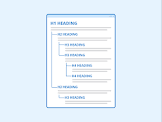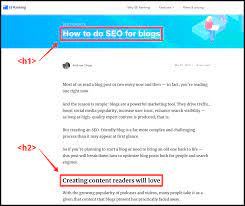Unlocking SEO Success: Maximising the Power of H1, H2, and H3 Heading Tags
The Importance of SEO Heading Tags: H1, H2, and H3
When it comes to optimising your website for search engines, heading tags play a crucial role in improving your visibility and ranking. Understanding the significance of H1, H2, and H3 tags is essential for creating well-structured and SEO-friendly content that resonates with both users and search engines.
H1 Tag: The Main Heading
The H1 tag is the most important heading tag on a webpage. It serves as the main title that summarises the content of the page. Search engines use the H1 tag to understand the primary topic of the page, so it is vital to include relevant keywords in your H1 tag. This helps search engines identify the context of your content and improves your chances of ranking for specific keywords.
H2 Tags: Subheadings for Organisation
H2 tags are used to create subheadings that break down the content into sections. They provide structure to your content and make it easier for readers to navigate through the information. From an SEO perspective, using H2 tags helps search engines understand the hierarchy of information on your page. Including relevant keywords in your H2 tags can further enhance your page’s visibility for specific search queries.
H3 Tags: Further Subdivision
H3 tags are used to create subsections within H2 sections. They offer additional organisation to your content by further dividing subtopics. While not as critical for SEO as H1 and H2 tags, using H3 tags can still benefit your website by providing a clear structure that improves readability and user experience.
By incorporating proper heading tags (H1, H2, and H3) into your website’s content, you not only enhance its SEO performance but also make it more user-friendly. Remember to use relevant keywords naturally within these heading tags to signal the relevance of your content to both users and search engines.
Overall, mastering the art of utilising SEO heading tags can significantly impact your website’s visibility, organic traffic, and overall success in attracting and engaging with your target audience.
8 Essential Tips for Optimising SEO with H1, H2, and H3 Headings
h1
The H1 tag, also known as the main heading, holds significant importance in SEO as it serves as the primary title that summarises the content of a webpage. Including relevant keywords in the H1 tag helps search engines understand the main topic of the page, thus enhancing its visibility and ranking potential. By optimising the H1 tag with targeted keywords related to your content, you can effectively signal to search engines what your page is about and increase its chances of appearing in relevant search results.
h2
The H2 tag serves as a valuable tool for structuring content and breaking it down into digestible sections. By utilising H2 tags effectively, website owners can enhance the readability of their content and improve user experience. Incorporating relevant keywords in H2 headings also helps search engines understand the hierarchy of information on a page, leading to better indexing and potentially higher rankings for targeted search queries. Including descriptive and informative subheadings with H2 tags not only aids in SEO but also guides readers through the content, making it easier for them to find the information they are looking for.
h3
When it comes to SEO and the hierarchy of heading tags, the H3 tag plays a crucial role in further subdividing content under H2 sections. While not as prominent as H1 and H2 tags, utilising H3 tags strategically can enhance the organisation and readability of your content. By incorporating relevant keywords and providing additional structure with H3 tags, you can improve both user experience and search engine visibility for specific subtopics within your content.
Understanding how to optimise your website’s heading tags, including H1, H2, and H3, is a fundamental aspect of effective SEO strategy. By strategically utilising these heading tags with relevant keywords, you can enhance the structure and readability of your content while signalling to search engines the key topics and subtopics of your page. Incorporating well-crafted heading tags not only improves your site’s search engine visibility but also enhances user experience by providing clear navigation and organisation within your content. Mastering the art of SEO heading tags is a powerful tool in boosting your website’s ranking and attracting organic traffic.
Understanding the nuances of SEO heading tags, including H1, H2, and H3, is crucial for creating content that is not only well-structured but also optimised for search engines. By strategically incorporating relevant keywords into these heading tags, website owners can improve their chances of ranking higher in search engine results pages. Properly utilising H1 as the main heading, H2 for subheadings, and H3 for further subdivision not only enhances the readability and organisation of content but also sends clear signals to search engines about the key topics covered on a webpage. Mastering the art of SEO heading tags is a fundamental aspect of effective on-page optimisation that can significantly impact a website’s visibility and overall SEO performance.
Understanding the role and importance of SEO heading tags, such as H1, H2, and H3, is essential for creating well-structured and optimised content. By strategically using these heading tags to organise and prioritise information on webpages, businesses can improve their search engine visibility and user experience. Incorporating relevant keywords in H1, H2, and H3 tags helps search engines better understand the context of the content, ultimately boosting rankings for targeted search queries. Mastering the art of utilising SEO heading tags is a fundamental aspect of effective on-page SEO strategy that can drive organic traffic and enhance overall website performance.
Understanding the role and importance of SEO heading tags, such as H1, H2, and H3, is crucial for enhancing your website’s search engine optimisation. By strategically utilising these heading tags to structure your content, you can improve readability for users and provide valuable signals to search engines about the relevance and hierarchy of information on your page. Incorporating relevant keywords in your heading tags can further boost your SEO efforts by increasing the visibility of your content for specific search queries. Remember, a well-organised content hierarchy with optimised heading tags not only benefits your SEO strategy but also enhances the overall user experience on your website.
Understanding the role and importance of SEO heading tags, specifically H1, H2, and H3, is crucial for enhancing your website’s search engine visibility. By strategically utilising these heading tags with relevant keywords, you can not only improve the structure and readability of your content but also signal to search engines the key topics and hierarchy of information on your page. Incorporating H1 as the main title, followed by H2 and H3 subheadings, helps both users and search engines navigate and comprehend your content effectively. Remember that a well-optimised hierarchy of heading tags can contribute significantly to your SEO efforts and ultimately drive more organic traffic to your website.

